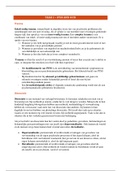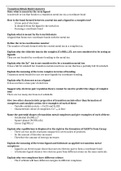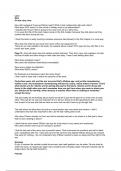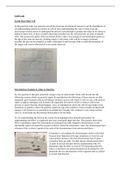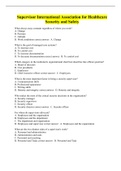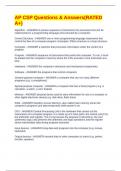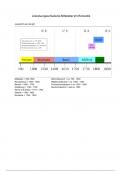Trauma
Enkelvoudig trauma; iemand heeft in dagelijks leven last van psychische problemen die
samenhangen met een nare ervaring. Als er sprake is van meerdere nare ervaringen gedurende
langere tijd, dan spreek je van een meervoudig trauma. Een complex trauma is een
combinatie van enkel- of meervoudig trauma met een of meerdere andere stoornissen. Er is
sprake van een trauma;
1) Wanneer je iets hebt meegemaakt waarbij je met de dood geconfronteerd werd of met
het aantasten van je persoonlijke grenzen.
2) Wanneer je gevoelens van ongeloof en machteloosheid hebt, en je de gebeurtenis als
verschrikkelijk en onoverkomelijk ziet.
3) Wanneer je het idee hebt dat je leven compleet veranderd is.
‘Trauma is often the result of an overwhelming amount of stress that exceeds one’s ability to
cope, or integrate the emotions involved with that experience’.
- Het hoofdkenmerk van PTSS is de ontwikkeling van kenmerkende symptomen na
blootstelling aan een psychotraumatische gebeurtenis. Het klinisch beeld van PTSS
varieert.
- Bij kinderen kan het bij seksueel gewelddadige gebeurtenissen ook gaan om
seksuele ervaringen zonder lichamelijk geweld of letsel die niet bij het
ontwikkelingsstadium passen.
- Een levensbedreigende ziekte of slopende somatische aandoening wordt niet als een
psychotraumatische gebeurtenis beschouwd.
Dissociatie
Dissociatie is een toestand van verlaagd bewustzijn. Je hersenen schakelen een stuk van je
bewustzijn uit, bijvoorbeeld je emotie, omdat het te veel dreigt te worden. Mensen die in hun
kindertijd langdurig blootgestaan hebben aan misbruik, mishandeling of verwaarlozing
hebben als volwassene vaak meer last van dissociatie dan anderen. Zij kunnen in hun
dagelijks leven last hebben van plotselinge dissociatie. Dit treedt dan vaak op in situaties
waarin ze een moment erg veel emotie ervaren, bijvoorbeeld angst/paniek. Vaak is dat dan in
situaties die in het verleden geassocieerd waren met bedreiging.
Als je last hebt van dissociatie kan het voelen alsof je gedachten, gevoelens, herinneringen en
lichamelijke gewaarwordingen niet van jezelf zijn (depersonalisatie). Ook kunnen de wereld
en de mensen om je heen kunnen heel vreemd aanvoelen (derealisatie).
• Depersonalisatie; persisterende of recidiverende ervaringen van gevoelens van
vervreemding van de eigen psychische processen of het eigen lichaam, alsof de
betrokkene zich van buitenaf waarneemt (het gevoel om in een droom te zitten, als het
eigen lichaam onwerkelijk is, alsof de tijd langzaam gaat).
• Derealisatie; persisterende of recidiverende ervaringen van gevoelens alsof de
omgeving niet echt is (bijvoorbeeld de wereld rondom de betrokkene wordt ervaren
als onecht, als in een droom, veraf of vervormd).
, POSTTRAUMATIC STRESS DISORDER
Source: Bovin, Wells, Rasmusson, Hayes & Resick (2014)
Diagnostic criteria PTSD
-Criterion A specifies that the person must have experienced or witnessed at least one event
that involved actual of threatened death, serious injury, or sexual violence, or must have
learned that the traumatic event occurred to a close family member/friend, or must have
experienced repeated or extreme exposure to aversive details of the traumatic event.
-Criterion B requires that the traumatic event is reexperienced in one of five ways; recurrent
and intrusive distressing recollections, recurrent distressing dreams of the event, acting or
feeling as though the even were recurring (flashbacks), intense physiological or emotional
distress upon exposure to internal or external reminders of the trauma.
-Criterion C has two components of avoidance, of which at least one must be present for
diagnosis. The person must make efforts to avoid thoughts, feelings or conversations about
the trauma, or attempt to avoid activities, places or people that elicit recollections.
-Criterion D comprises seven different criteria representing negative alterations in
cognitions and mood; inability to recall important aspects of the trauma, persistent and
exaggerated negative beliefs, self-blame, persistent negative emotional state, diminished
interest or participation in important activities, feeling detached or estranged from others,
restricted of affect. At least two of these symptoms must be present for diagnosis.
-Criterion E requires two of the following symptoms indicative of arousal; difficulty falling
or staying asleep, irritability or outbursts of anger, reckless or self-destructive behavior,
difficulty concentrating, hypervigilance, and exaggerated startle response.
-Criterion F requires the B, C and D symptoms to last at last 1 month, and the last two
criteria specify that the symptoms must cause clinically significant distress or impairment in
functioning (Criterion G) and are not due to the effects of a substance or a medical condition
(Criterion H).
Epidemiology of trauma and PTSD
Many people experience potentially traumatic events (PTE) over the course of their
lifetimes, but PTSD can only be diagnosed following a traumatic event. Studies suggest that
61% of men and 51% of women experience a traumatic event during their life. Gender; men
and women experience different types of traumatic events; men tend to experience more war-
zone and combat traumas, women experience higher rates of child sexual abuse, molestation,
rape and intimate partner violence.
Immediately following a trauma, most people experience an increase in psychological
distress. For the majority of individuals, these symptoms will quickly remit. The life-time
prevalence of PTSD is approximately 8% among the general population. In this study,
women’s lifetime prevalence (10%) was twice as high as men’s (5%). Of those exposed to a
traumatic event, 23,6% of people meet criteria for PTSD over the course of their lifetimes.

